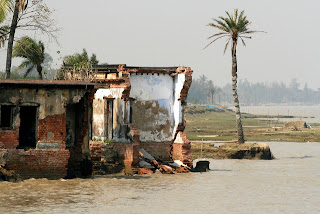
The funniest part however is that everyone seems to believe that this is a brand new event even though official records show that the farmer suicides have been going since the early 1990's. What has completely devastated several districts, including Anantapur, is a long running drought that began in 2001 and is yet to end. At the Nairobi summit of the United Nations Framework Convention on Climate Change, there was a strong focus on the fact that those most likely to be severely affected will be people who had no hand in propagating the anthropogenic factors that have escalated climate change. It will be the poorest of the poor, the landless, the economically backward, the socially marginalized. All of which describe the farmers of Andhra Pradesh.
The most terrifying truth about this scenario is the fact that these farmers are being crushed between the jaws of the Globalisation mantra and unreliable climate patterns. The Indian farmer has traditionally relied on the monsoons for sustenance, they are his benefactors. They are his cruel masters; to whose whims and mercies lies bound, inextricably, his life. In the WTO regime, that really, desperately wants us to believe that 'the world is flat', people such as these farmers have no voice, no power and no access to the wealth that the WTO promises to bring to people exactly like them; honest, hardworking and desirous of a 'good life.'

Now, that promise stands forfeited. There is no salvation in sight for these people with no financial lending institution or government organisation willing to take up the responsibility for improving the situation. Indeed many of the small scale private banks which were supposed to exist as the farmers friend now no longer give out loans to them. Their new clientèle is the upper middle class urban population.
To spice up things, Andhra Pradesh regularly experiences the same troubles as Orissa. Storms, cyclones near the coasts and prolonged drought inland. Nature's double whammy which, compounded by the failure of government policy and the competition from cheaper food grain imports, seems to be the surefire solution to India's overpopulation problem; 'Kill them all!'

I know I shouldn't sound so depressing and negative, but most of what I typed above is so terribly true, I don't know if it makes a difference if I package it in tinfoil and ribbons.
Going back to the discussion on climate change, it is not really difficult to imagine how climate change is going to further worsen the situation in Andhra Pradesh. Erratic precipitation, unending droughts, government apathy and repeatedly failing crops. India is already incapable of feeding her masses. Now farmer after farmer is giving up on agriculture. There is little left to imagine about what the future holds unless some corrective action takes place.
References:
P Sainath on the state of farmers in Andhra and Maharashtra
p.s. - Palagummi Sainath is this year's winner of the Ramon Magasasay award. He is the rural affairs editor for The Hindu, a leading daily in India.




